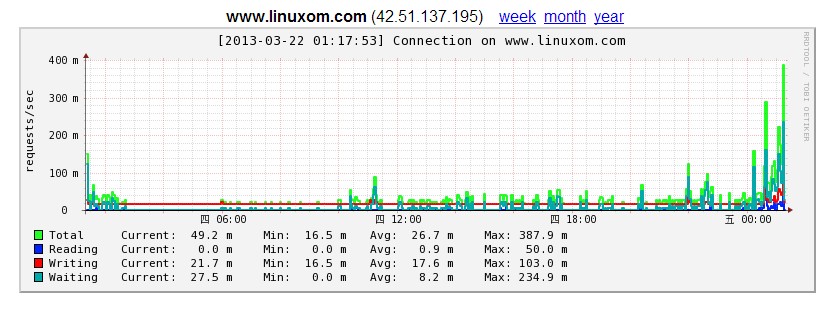CentOS下用nginx-rrd监控nginx访问数
时间:2014-05-04 23:47 来源:linux.it.net.cn 作者:IT网
可以使用cacti、nagios等监控程序监控nginx服务器,不过有时候不用那么复杂,用nginx-rrd就能完成连接、请求的监控功能。
首先编译安装nginx,注意加载stub_status模块,Nginx中的stub_status模块主要用于查看Nginx的一些状态信息.
本模块默认是不会编译进Nginx的,如果你要使用该模块,则要在编译安装Nginx时指定
-
tar xzvf nginx-1.2.0.tar.gz
-
cd nginx-1.2.0
-
./configure --prefix=/usr/local/nginx --with-http_stub_status_module
-
make && make install
yum安装相关的perl、rrdtool的rpm包
-
yum install perl rrdtool perl-libwww-perl libwww-perl perl-rrdtool
确定 rrdtool 和相应的perl 被安装上后,开始安装nginx-rrd
-
tar zxvf nginx-rrd-0.1.4.tgz
-
cd nginx-rrd-0.1.4
-
cp -p usr/sbin/* /usr/sbin //复制主程序文件到 /usr/sbin 下
-
cp -p etc/nginx-rrd.conf /etc //复制配置文件到 /etc 下
-
-
创建nginx-rrd生成目录
-
mkdir /usr/local/nginx/html/rrd
-
cp html/index.php /usr/local/nginx/html
这里提醒需要修改 index.php文件的默认访问密码WCO。

编辑修改/etc/nginx-rrd.conf
-
vim /etc/nginx-rrd.conf
-
-
#####################################################
-
#
-
# dir where rrd databases are stored
-
RRD_DIR="/usr/local/nginx/html/rrd";
-
# dir where png images are presented
-
WWW_DIR="/usr/local/nginx/html";
-
# process nice level
-
NICE_LEVEL="-19";
-
# bin dir
-
BIN_DIR="/usr/sbin";
-
# servers to test
-
# server_utl;server_name
-
SERVERS_URL="http://www.linuxom.com/nginx_status;www.linuxom.com"
多个虚拟主机,可以SERVERS_URL中空格分开,前部分为nginx_status 的地址,后面为被监控主机的域名。
查看已安装的nginx是否包含stub_status模块
-
/usr/local/nginx/sbin/nginx -V
-
nginx version: Nginx/1.2.0
-
configure arguments: --with-http_stub_status_module
确定支持stub_status模块后编辑修改nginx.conf
-
vim /usr/local/nginx/conf/nginx.conf
-
-
//server{} 中,需要已经加入如下内容
-
location / {
-
root html;
-
index index.php index.html index.htm;
-
-
location /nginx_status {
-
stub_status on; //这个选项参数就是在编译时对stub_status模块的支持,如果不编译加入则会在启动nginx时有警告信息
-
access_log off;
-
}
-
-
-
}
-
-
#error_page 404 /404.html;
-
-
# redirect server error pages to the static page /50x.html
-
#
-
error_page 500 502 503 504 /50x.html;
-
location = /50x.html {
-
root html;
-
}
-
-
# proxy the PHP scripts to Apache listening on 127.0.0.1:80
-
#
-
#location ~ \.php$ {
-
# proxy_pass http://127.0.0.1;
-
#}
-
-
# pass the PHP scripts to FastCGI server listening on 127.0.0.1:9000
-
#
-
// 去掉如下内容的注释,这里是对php的支持,注意文件路径
-
location ~ \.php$ {
-
root html;
-
fastcgi_pass 127.0.0.1:9000;
-
fastcgi_index index.php;
-
fastcgi_param SCRIPT_FILENAME /usr/local/nginx/html$fastcgi_script_name;
-
include fastcgi_params;
-
}
重启Nginx服务器
-
/usr/local/nginx/sbin/nginx -s reload
设置定时收集数据
-
crontab -e
-
* * * * * root /usr/sbin/nginx-collect
-
*/10 * * * * root /usr/sbin/nginx-graph
访问页面http://域名/index.php,nginx的连接数如下图

nginx请求数如下图

(责任编辑:IT)
| 可以使用cacti、nagios等监控程序监控nginx服务器,不过有时候不用那么复杂,用nginx-rrd就能完成连接、请求的监控功能。 首先编译安装nginx,注意加载stub_status模块,Nginx中的stub_status模块主要用于查看Nginx的一些状态信息. 本模块默认是不会编译进Nginx的,如果你要使用该模块,则要在编译安装Nginx时指定
确定 rrdtool 和相应的perl 被安装上后,开始安装nginx-rrd
这里提醒需要修改 index.php文件的默认访问密码WCO。
 编辑修改/etc/nginx-rrd.conf
查看已安装的nginx是否包含stub_status模块
重启Nginx服务器
访问页面http://域名/index.php,nginx的连接数如下图
 nginx请求数如下图  (责任编辑:IT) |